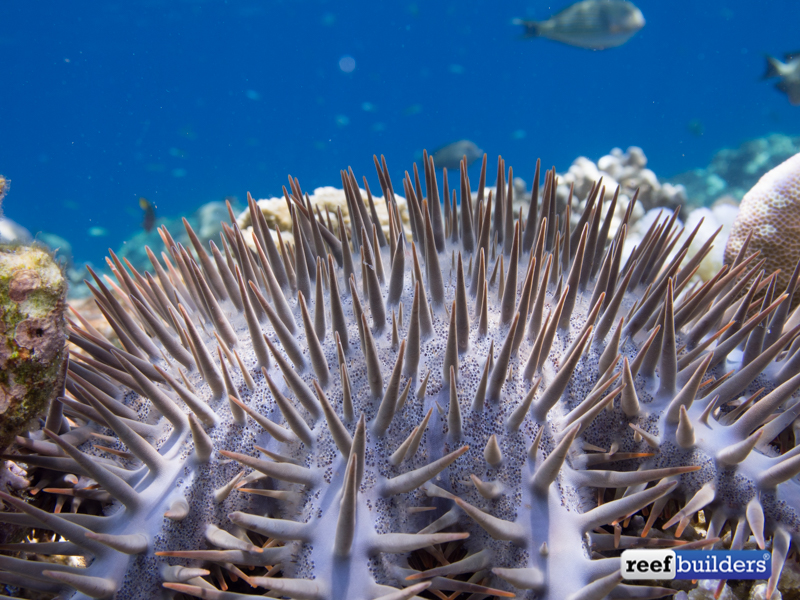Acanthaster planci, more commonly known as the Crown-of-Thorn starfish, is a voracious predator which feeds on stony coral polyps. The starfish gets its name from the toxic thorn-like spines covering its body, which resemble a biblical “crown of thorns”.
The Crown-of-Thorns starfish is wide spread and found mainly in Australia and the Indo-Pacific. Unfortunately, the Crown-of-Thorns is becoming more common outside the Indo-Pacific and is known to occur in the tropical and subtropical regions of East Africa, the Red Sea, and have been documented as far away as South America, where you find coral reefs. Crown-of-Thorns prefer to feed on branching or table corals like Acorpora sp. but will also feed on Porites or Motipora corals, and have been documented feeding on sponges, soft corals, and encrusting organisms like algae.
If you happen to come across one of these starfish DO NOT touch the body or long spines as this can cause a severe sting, pain, and swelling that can last for hours or days. We have even met people who have had an accidental run-in with the starfish and years later can still feel part of the spine left in their fingers or hand; you’ve been warned!
One or two Crown-of-Thorn starfish on a reef may be arguably beneficial for biological diversity as they keep down the growth of fast-growing coral species and leave space for other, slow-growing corals. However, as the starfish population multiplies or the starfish begin eating coral tissue faster than it can grow back a devastating Crown-of-Thorn (COTS) outbreak can occur. It is not known exactly what causes a COTS outbreaks, however, scientists agree it could have something to do with increased levels of nutrients in the water due to agriculture runoff or warming oceans, leading to a plankton bloom which is a necessary food source for starfish larvae.
The main predators of the Crown-of-Thorns starfish include the giant triton snail, the stars and stripes pufferfish (Arothron hispidus), the titan triggerfish (Balistoides viridescens), and the humphead wrasse (Cheilinus undulates), and increasing starfish density on a reef can be caused by loss of their main predators due to overharvesting.
A COTS outbreak can have devastating impacts to an entire coral reef, and depending on the event the ravenous starfish could wipe out nearly all living corals. Crown-of-Thorns are among some of the larges starfish species, generally 25-35cm (10-14inch) in diameter and can grow to a size of 80cm (31inch), this makes them easy to spot on a reef and recently we have been seeing some new methods for controlling COTS outbreaks.
Removing or killing the starfish is still the best methods for controlling these outbreaks, however cutting into the body in an attempt to kill them won’t do much as the starfish, or smaller pieces are known to heal and regenerate, and you wouldn’t want to go picking up these prickly menaces without some seriously heavy duty gloves. Researchers in Australia have found that COTS can be killed by lethal injection (of bile salt or vinegar), which kills the starfish within 24hrs.
The injection method can be used against 1,000 starfish on a single 40-minute dive and in two years (2012-2014) researchers from the James Cook University have been successful in eradicating more than 250,000 Crown-of-Thorns starfish from the Great Barrier Reef in Queensland. The Crown-of-Thorns is most prevalent in Australian reefs, and although effective, this method is limited as it requires divers underwater to administer the injection.

Enter COTSBot, a new robotic “terminator” designed by researchers at Australia’s Queensland University of Technology (QUT) to seek and destroy COTS and deliver a lethal injection of poison. COTSbot is equipped with stereoscopic cameras, giving it depth perception, five thrusters to maintain stability, GPS and pitch-and-roll sensors and a unique pneumatic injection arm to deliver the fatal dose.
The COTSbot can be deployed for up to eight hours, delivering over 200 lethal shots. Dr Matthew Dunbabin creator of the COTSBot said “Human divers are doing an incredible job of eradicating this starfish from targeted sites but there just aren’t enough divers to cover all the COTS hotspots across the Great Barrier Reef,” “We see the COTSbot as a first responder for ongoing eradication programmes – deployed to eliminate the bulk of COTS in any area, with divers following a few days later to hit the remaining COTS.”






